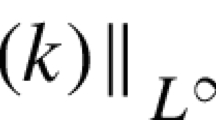Summary
A family of one-dimensional nonlinear dispersive wave equations is introduced as a model for assessing the validity of weak turbulence theory for random waves in an unambiguous and transparent fashion. These models have an explicitly solvable weak turbulence theory which is developed here, with Kolmogorov-type wave number spectra exhibiting interesting dependence on parameters in the equations. These predictions of weak turbulence theory are compared with numerical solutions with damping and driving that exhibit a statistical inertial scaling range over as much as two decades in wave number.
It is established that the quasi-Gaussian random phase hypothesis of weak turbulence theory is an excellent approximation in the numerical statistical steady state. Nevertheless, the predictions of weak turbulence theory fail and yield a much flatter (|k|−1/3) spectrum compared with the steeper (|k|−3/4) spectrum observed in the numerical statistical steady state. The reasons for the failure of weak turbulence theory in this context are elucidated here. Finally, an inertial range closure and scaling theory is developed which successfully predicts the inertial range exponents observed in the numerical statistical steady states.
Similar content being viewed by others
References
F. P. Bretherton, “Resonant interactions between waves. The case of discrete oscillations,”J. Fluid Mech.,20, 457–479, 1964.
D. J. Benney and P. G. Saffman, “Nonlinear interactions of random waves in a dispersive medium,”Proc. Roy. Soc. A289, 301, 1965.
A. D. Craik,Wave Interactions and Fluid Flows, Cambridge Univ. Press, Cambridge, 1985.
S. Dyachenko, A. C. Newell, A. Pushkarev, and V. E. Zakharov, “Optical turbulence: Weak turbulence, condensates, and collapsing filaments in the nonlinear Schroedinger equation,”Physica D,57, 96–160, 1992.
K. Hasselmann, “On the nonlinear energy transfer in a gravity wave spectrum. Part I: General theory,”J. Fluid Mech.,12, 481–500, 1962.
T. Y. Hou, J. S. Lowengrub, and M. Shelley, “Removing the stiffness from interfacial flows with surface tension,”J. Comp. Phys.,114, 312–338, 1994.
A. J. Majda, D. W. McLaughlin, and E. G. Tabak, “A one-dimensional model for dispersive wave turbulence: Part II,” in preparation.
O. M. Phillips,The Dynamics of the Upper Ocean, Cambridge Univ. Press, Cambridge, 1977.
V. E. Zakharov, “Kolmogorov spectra in weak turbulence problems,”Handbook Plasma Phys.,2, 1984.
V. E. Zakharov, V. Lvov, and G. Falkovich,Wave Turbulence, Springer-Verlag, New York, 1992.
Author information
Authors and Affiliations
Additional information
Communicated by Stephen Wiggins
Rights and permissions
About this article
Cite this article
Majda, A.J., McLaughlin, D.W. & Tabak, E.G. A one-dimensional model for dispersive wave turbulence. J Nonlinear Sci 7, 9–44 (1997). https://doi.org/10.1007/BF02679124
Received:
Accepted:
Issue Date:
DOI: https://doi.org/10.1007/BF02679124




